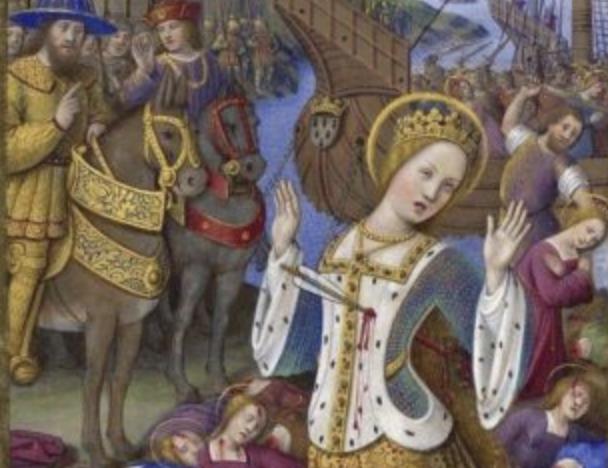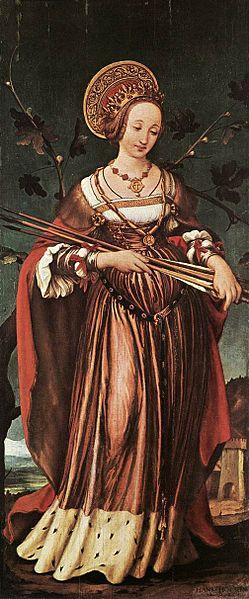Today is the feast day of Saint Ursula (c301 to 383 CE), a British princess who was according to the story was martyred with 11,000 virgins in the city of Cologne. The Church of S. Ursula in Cologne bears a 4th or 5th Century inscription designating it as the site where virgins were killed. An ancient Roman burial ground found in1155 contained bones believed to have been those of the virgins. Several versions of the legend of St Ursula have been found. Images of St Ursula were popular from the Gothic period until the 18th Century, when religious imagery declined in general. Sculptures outside and inside Catholic churches were used to relay the Christian message to the generally illiterate congregations. Paintings and illuminated manuscripts were commissioned by the very wealthy for their homes, private chapels and personal use. Even the very wealthy were often illiterate.
Hans Holbein the Younger’s “St Ursula” (1523) (38’’x 16.4’’) is the traditional representation of the saint. Ursula, a beautiful, young princess was pledged in marriage by her father to a Pagan king. Ursula, devoutly Catholic, objected to the match and contrived to end it. Before the marriage, and at her suggestion, her prospective groom agreed she could make a holy pilgrimage. Unforeseeably, it would end with her death.
Hans Holbein, a German painter largely known for his years as court painter to Henry VIII (1532-1543), began painting portraits while he was in Basel in 1523. He dresses St Ursula in royal finery with an elaborate gold crown, rich copper colored gown with an ermine hem, gold jewelry, and a girdle belt decorated with metal medallions. St Ursula’s symbol is the arrow, the instrument of her death, and Holbein shows her holding a bundle of arrows. St Ursula stands in front of a tree with leaves and buds that suggest angel wings.
Ursula, hoping her excessive request would doom the engagement, required her fiancé to supply ten women of noble birth to attend her, each one to be attended by one thousand virgins. In addition, she required 11 ships and supplies for the expected three-year pilgrimage. He agreed. When Ursula and the virgins departed, a miraculous storm brought them from Britain to Cologne in one day.
That night in Cologne, Ursula was visited by an angel who told her the pilgrimage would end with her receiving the crown of Christian martyrdom. In “The Dream of Ursula” (1492) by the Master of the Legend of St. Ursula, she is not asleep, but awake. Her hands are folded in prayerful acceptance. The angel, hands gesturing, tells Ursula of her coming martyrdom. The Angel wears an elaborate brocade cope (cloak) with a large pearl and jewel encrusted clasp. The angel is surrounded by a blazing light.
Unable to create accurate perspective, the artist places the figure of St Ursula in an enormous bed that dwarfs her. The head board of the bed is painted with a garden of flowers, referencing the popular subject of the Virgin with virgin saints in a garden. The use of flowers as symbols began with the Bible. Painted on the head board are pink roses symbolic of gratitude and peace, white roses for purity and holiness, and yellow roses for friendship, all qualities of Ursula. Friendship is reflected by several of her companions who can be seen in a room at the upper right.
After leaving Cologne, the pilgrims continued their journey to Basel, Switzerland, and from there walked barefoot overland to Rome. Vittore Carpaccio (1465-1526), a Venetian painter, was commissioned in 1490 by the School of Saint Ursula (a charitable and social confraternity) in Venice to paint nine wall paintings of the life of Saint Ursula.
“Meeting of Pope Cyriacus and the Pilgrims” (1498), depicts Ursula, in a light blue gown, kneeling before the Pope and the large number of prelates who have come to greet her and her companions. To place the scene in Rome, Carpaccio places in the background the very recognizable Mausoleum of the Roman Emperor Hadrian. It was renamed Castle Sant’ Angelo in the 6th Century, when a deadly plague struck Rome and the Archangel Michael was seen on the top of the tower. Shortly thereafter the plague abated.
“St Ursula’s Shrine” (1489) (34’’long x 13’’ wide x 35.8’’ tall) (gilded and painted wood) was commissioned by the monks of the Saint John’s Hospital in Bruges, Belgium, to hold the bones of St Ursula. Hans Memling (1430-1494) designed the shrine to resemble a Flamboyant Gothic chapel. The roof top features highly decorative pinnacles, crockets, finials, and six tondos (rounds), painted by another artist. Six arches on the sides of the shrine are painted with the story of St Ursula, in place of stained-glass windows. At one end the painting ‘’Virgin and Child’’ can be seen, and at the opposite end is the painting ‘’St Ursula and the Virgins’’. On St Ursula’s birthday (October 21, 1489) a ceremony was held in the hospital’s church to transfer the relics to the shrine.
The two images in the picture show all sides of the shrine. The left image shows the “Virgin and Child” with three scenes from left to right: the departure of St Ursula and the virgins, the arrival in Cologne, and Ursula greeted by the Pope in Rome. The image on the right shows St Ursula holding her cloak open to encircle and protect the virgins beneath it. The first scene on the side is of the departure of the group from Rome to Britain. The last two arches contain one scene, the arrival of the group in Cologne where they encounter the Huns, who begin the slaughter of the virgins. The execution of S Ursula can be seen at the right.
“The Death of St Ursula” (1503-08) (Grande Heures of Anne of Brittany), by Jean Bourdicon, depicts the Huns in the act of beheading the virgins. St Ursula was singled out to be shot with an arrow. She falls to the ground in a kneeling position and raises her hands in a gesture of acceptance. Surrounding her on the ground are the bodies and severed heads of the virgins, all with gold halos. Behind Ursula and the Huns is a long stretch of the Rhine River, a fortress, and distant mountains. The pagan Huns had been warned of the large retinue of more than 11,000 Christians coming to Cologne, and they killed them to stop the growth of Christianity.
“Apotheosis of St Ursula and Her Companions” (1491) was painted for the altar of the School of St Ursula. Carpaccio shows St Ursula standing above the others on a column encased in palm branches bound together near the base by two bands of red-faced cherubim. Palm branches are the symbol of all martyrs. The virgins kneel around Ursula. Her spiritual mission was so compelling that the Pope, warned by Ursula of the impending martyrdom, decided to go with her. A number of bishops and clergy decided to go as well. Noticeable at the left is the three-tiered Papal tiara of Pope Cyriacus. Ursula is surrounded by heavenly light and is welcomed by six cherubs. Two large red flags bearing the cross of resurrection direct the viewer’s attention upward to the outstretched arms of God. The entire composition is enclosed by a massive arch. Behind St Ursula is a clear blue sky and a green hilly landscape. Carpaccio’s use of reds from bottom to top guide the viewer throughout the painting and highlights the major figures.
In 1969, the Feast Day of St Ursula was removed from the Catholic Church calendar and reduced to a day of observance as a result of a lack of credible evidence of her existence. However, St Ursula has left her mark. Abbess Hildegard of Bingen (1098-1179) composed chants in honor of S Ursula. On his voyage home from America in 1493, Christopher Columbus passed a group of islands in the Caribbean, and he named them the Virgin Islands. In 1520, Magellan named Cape Virgenes, Argentina, after the Virgins. Angela Merici founded the Order of Ursulines in 1535, to educate young girls, and St Ursula is the patron saint of many girls’ schools. In the cities of Basel, Cologne, and Bruges, S Ursula holds a sacred place, and the cult of S Ursula reached as far as India and China.
Beverly Hall Smith was a professor of art history for 40 years. Since retiring with her husband Kurt to Chestertown six years ago, she has taught art history classes at WC-ALL and Chesapeake College’s Institute for Adult Learning. She is also an artist whose work is sometimes in exhibitions at Chestertown RiverArts and she paints sets for the Garfield Center for the Arts.







Write a Letter to the Editor on this Article
We encourage readers to offer their point of view on this article by submitting the following form. Editing is sometimes necessary and is done at the discretion of the editorial staff.